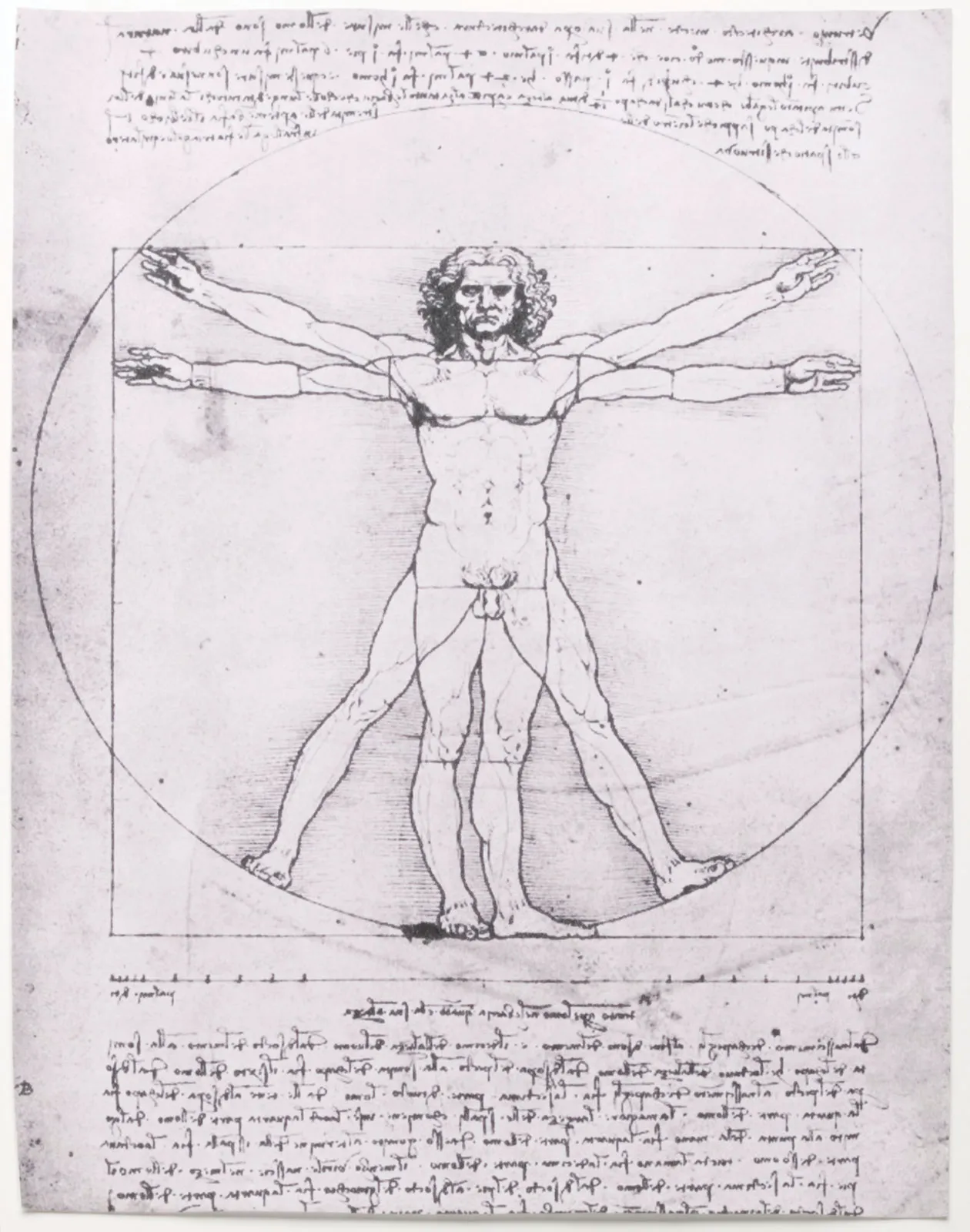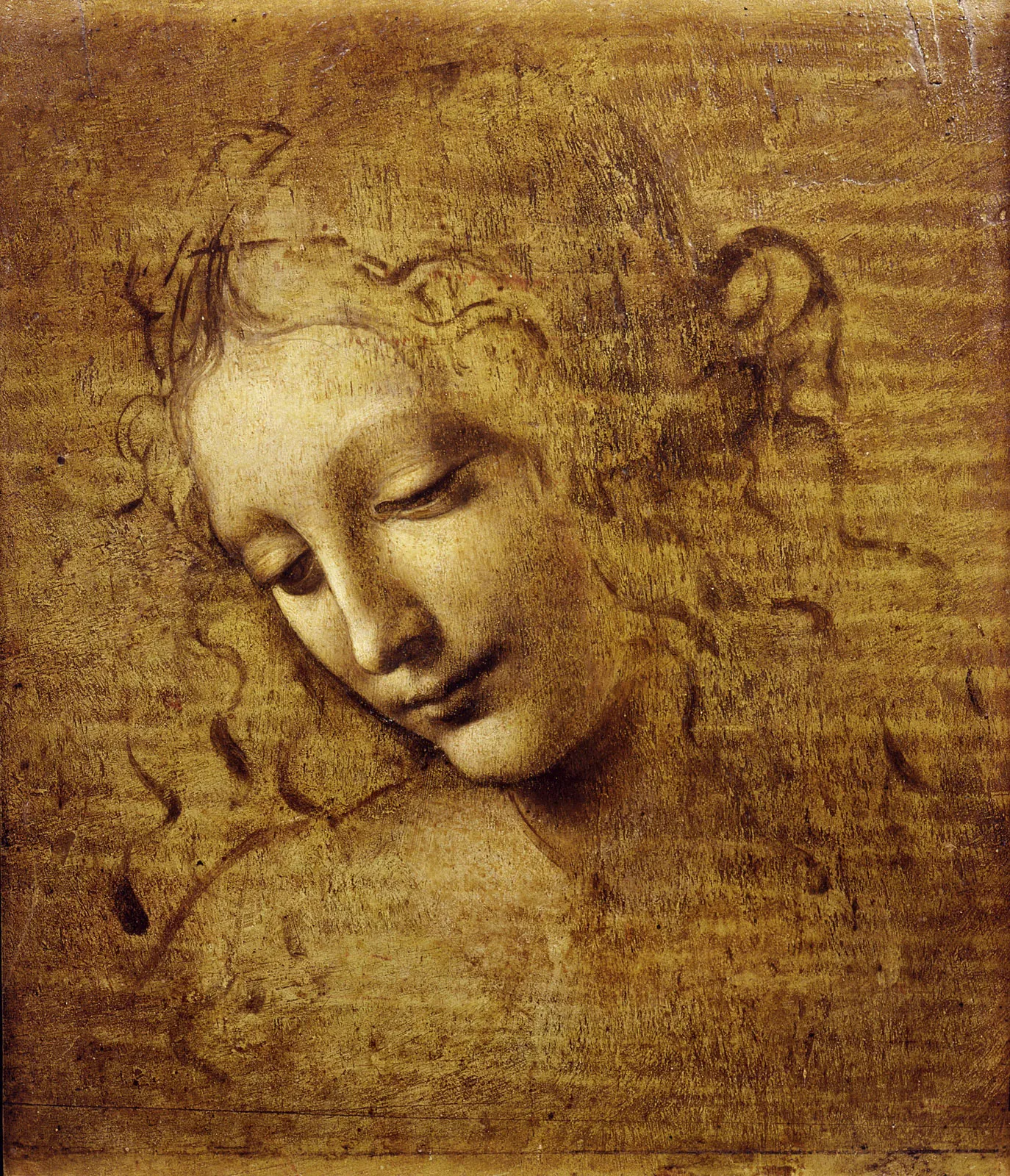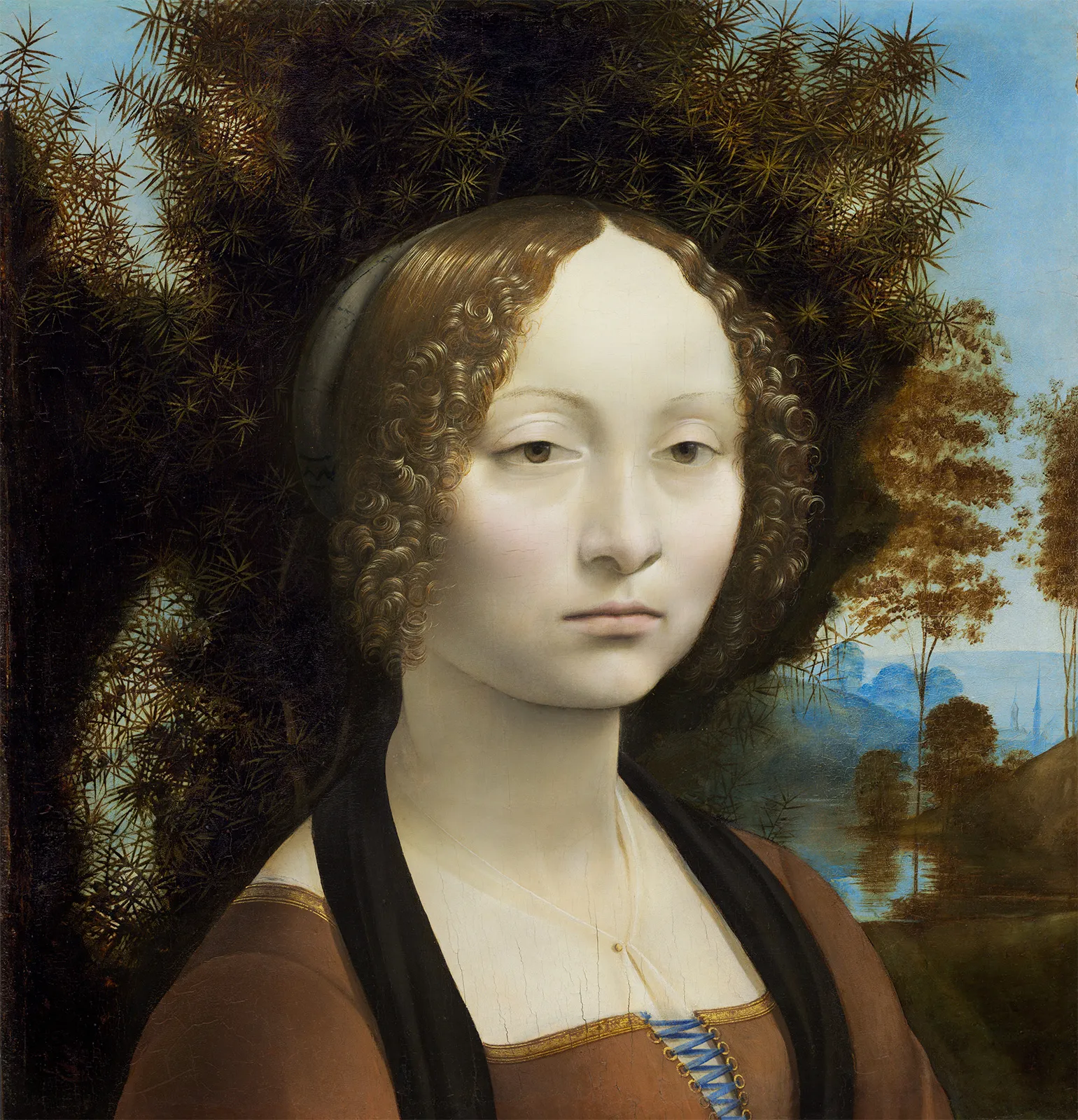1. the Mona Lisa

(c. 1503-19)
The world's most famous work of art, the Mona Lisa, attracts thousands of visitors to the Louvre every day, and its mysterious gaze and enigmatic smile captivate viewers.
At first glance, the portrait of a young woman wearing a thin veil, plain colors, and no jewelry appears unremarkable. However, it certainly has the effect of confusing the viewer at the same time.
The first thing people who have actually seen the painting say is that it is surprisingly small.
In fact, it looks much smaller than the crowds that have flocked to see the world's most famous work. However, it is equally certain that Leonardo's exceptional talent is evident in the small size of the painting.
The faces of the subjects are softly painted, showing Leonardo's mastery of sfumato, an artistic technique that uses subtle gradations of light and shadow rather than lines to express form.
The delicately painted veil, finely braided hair, and carefully folded cloth also reveal Leonardo's tireless patience in recreating his observations.
Moreover, the slightly bemused expression on the subject's face adds to the realism of the image. Whether her smile is charming or derisive is not clear to the viewer, for she is a complex figure who, like humans, simultaneously embodies conflicting characteristics.
2. the Last Supper
.webp)
(c. 1495-98)
One of the most famous paintings in the world, The Last Supper was commissioned by Ludovico Sforza, Duke of Milan, for the church of Santa Maria delle Grazie, a Dominican monastery.
This church was also the patron of Milan, Leonardo's first place of residence.
In the Gospel of Matthew, where Jesus declares that one of his apostles will betray him and gives him the chalice, the scene of betrayal is depicted as a continuous narrative in this mural.
Leonardo, who was interested in how a person's character is expressed in their posture, facial expressions, and gestures, depicted the disciples' reactions to Jesus' declaration in different expressive and gestural ways.
The postures of the apostles rise and fall, stretch and contract, intertwine, and seem to whisper, shout, lament, and argue with Jesus seated quietly in the center.
Because of the experimental painting method of applying two coats of tempera or oil paint over a base coat, the screen peeled off soon after completion. It has now been restored and has acquired a robust durability.
3. the human body in the style of Vitruvius

Leonardo's drawing "Vitruvian Figure" is from one of the many notebooks he kept with him during his mature years.
It is accompanied by notes written in mirror script about the ideal proportions of the human body as given by the Roman architect Vitruvius in his books on architecture in the 1st century BC.
The painting represents Vitruvius' teaching that the ideal human being fits within the incompatible shapes of a circle and a square.
Therefore, Leonardo superimposed two figures: a man with his arms outstretched to fit into a square, and a man with his legs outstretched to fit into a circle.
This work shows not only an effort to understand an important text, but also a willingness to develop it further.
Although Leonardo was not the first to draw the concept of Vitruvius, it later became one of the most iconic drawings of the Renaissance period, in part because of its fitting fusion of mathematics, philosophy, and art. The drawing is now in the collection of the Galleria dell'Accademia in Venice, but is not usually exhibited; it is kept in an air-conditioned archive.
4. self-portrait

(c. 1490/1515-16)
This red chalk painting of an old man with long wavy hair and beard has long been considered a self-portrait, and many people think of it when they think of Leonardo.
However, some scholars have argued that the burly face, furrowed brow, and slanted eyes make the figure look much older than Leonardo was when he died at the age of 67.
They say that this portrait may be one of the grotesque sketches of the figure that he was always drawing in his notebooks.
Regardless, this portrait stands apart from Leonardo's other beautiful paintings and seems to evoke the nobility and wisdom of the artist's mature years.
5. the Virgin of the Grottoes
.jpg)
(c. 1483-86)
Many scholars believe that the "Madonna of the Rocks" in the Louvre is one of two paintings depicting the legend of the Apocalypse, in which the Holy Family meets John the Baptist after fleeing Herod's "slaughter of the innocents" in Egypt.
As a result of years of litigation with the Church of the Immaculate Conception, which commissioned the work, Leonardo painted another version of the painting around 1508, which is now in the collection of the National Gallery in London.
This first painting is said to mark the arrival of Leonardo's Golden Age of the Renaissance.
Paintings of this period usually depicted figures arranged linearly, separated from each other, and painted with rigid forms.
In "Madonna of the Rocks," however, the Virgin Mary, the Christ Child, the Infant John, and the Archangel are arranged in a pyramid shape, not only occupying space but also exchanging gestures and glances.
The young Mary is seated not on a throne, as depicted in many early Renaissance paintings, but on the mysterious rocky ground.
Her body seems to sway as she tilts her head to protect the infant John, who kneels to her left in prayer, as if to coax him to the infant Christ on her right.
The archangel points toward John in a complex pose, glancing toward the viewer as Jesus blesses John. Leonardo has also eliminated the traditional holy symbols of the halo for Mary and Christ and the scepter for John, making the Holy Family appear less divine and more human.
6. female head

1500-10
This is a small work of painting.
It depicts a young woman with her head tilted back and her eyes downcast. The figure is reminiscent of the Virgin Mary in Leonardo's "Madonna of the Rocks," and it is thought that the same woman may have been the model.
The painting's nickname, "La scapigliata," translates as "the disheveled" and refers to the young woman's disheveled hair.
Although the hair bunches and shoulders are loosely drawn, the face is highly finished, gently modeling the woman's delicate features, from her heavy eyelids to her soft lips.
The work reveals Leonardo's mastery of shaping contours with expressive strokes and rendering details with carefully controlled rendering.
7. lady holding a marten

(c. 1489 - 1491)
Many art historians believe that the young woman depicted in Lady with a Baijiao is Cecilia Gallerani, the mistress of Leonardo's patron, Duke Ludovico Sforza of Milan.
The dervish was often used as the duke's coat of arms.
The woman turns to the right, her shining eyes seemingly directed toward something outside the frame.
Although this painting has been painted with a lot of brushwork, including darkening the background, it still shows Leonardo's knowledge of anatomy and his ability to express the figure in terms of posture and expression.
The reticent face, watchful gaze, and the gentle embrace of the dervish, who is standing proudly with her head tilted back in alarm, show the youthfulness and good-naturedness of the noblewoman.
Her slender hands show the intricate skeleton beneath the skin, and the ocotillo's head seems to give a sense of the skull beneath the elaborately painted fur.
8. Salvador Mundi

(c. 1500)
In 2017, a Salvator Mundi (c. 1500, "Savior of the World") portrait made headlines when it sold at auction for a record-breaking $405.3 million.
The high price was all the more surprising considering that the Salvator Mundi was in poor condition, its authenticity was in doubt, and its authenticity was the subject of debate among scholars and critics.
Many pundits have pointed out the poor technique used to represent the face of Jesus, the stiff posture that is quite different from the twisting pose characteristic of the Renaissance masters, the unconvincing representation of the glass sphere, and the optical trickery that Leonardo would have known would have distorted the reflection of its owner if it had been solid.
However, Christie's, which exhibited the work, brushed off these criticisms, stating that the poor workmanship was the result of the great restorations of the previous century, and that the soft modeling of Jesus' right hand and the delicacy of the tight curls were similar to Leonardo's technique.
He also asserted that conservators have confirmed that the painting was painted with the same materials as Leonardo, particularly ultramarine, an expensive, high-quality blue pigment used only by masters.
Regardless of its authenticity, the interest in the work and the high price paid for it at auction certainly attest to Leonardo's immortal reputation and his powerful position in the history of art in the five centuries following his death.
9. portrait of Ginevra de' Bench

(c. 1474/78)
Portrait of Ginevra de Bench, on display at the National Gallery of Art in Washington, D.C., is the only painting by Leonardo on permanent display in the Western Hemisphere.
It is an early work, completed by Leonardo in his early twenties, and offers a glimpse of the unconventional techniques he would employ throughout his career.
Influenced by Northern European painters, Leonardo broke with tradition by depicting the majestic young woman in a three-quarter pose rather than the usual profile, and is believed to have been the first Italian artist to paint such a composition.
Subsequently, the three-quarter view was adopted for all portraits, including the Mona Lisa, and became the standard for portraiture, and is still used as a matter of course today.
The presence of fingerprints on the surface of the paint also points to the possibility that Leonardo painted with his fingers when the paint was still hard.
On the reverse, a garland of laurel and palm fronds surround a sprig of juniper (Ginepro in Italian), with a Latin scroll reading, "Beauty adorns virtue," entwined around each plant.
The obverse is truncated, suggesting that the lower portion of the painting may have been cut off due to damage from water or fire.
Some scholars have speculated that the portrait on the obverse may have depicted Ginevra's hands, and it is possible that the Silver Point study of arms and hands in the collection of Windsor Castle was used as a preparatory drawing.
10. the Virgin and Child with St. Anne
%20copy.png)
(c. 1503-19)
The Madonna and Child with St. Anne is believed to be Leonardo's last work.
It is usually regarded as Leonardo's last work to depict the Holy Family of three generations, St. Anne, her daughter, the Virgin Mary, and the Infant, in the canonical style that he had established.
At the apex of the pyramidal composition, Anne is seated on her knees, gazing at Mary, while the Virgin gently restrains Christ as he rides his lamb.
In contrast to the knowing infant Leonardo depicted in "Madonna of the Rocks," the Christ figure in "Madonna and Child with Anne" appears innocent, playfully childlike, and trusting as he meets the gaze of his mother.
The intimate interactions between the figures show Leonardo's ability to express convincing human relationships.
It also reveals Leonardo's lifelong commitment to expressing three-dimensional space in two dimensions.
As in many of his works, the figures are placed in fantastic landscapes. In his "Treatise on Painting," Leonardo used the technique of "aerial perspective," in which he painted the rocky mountains in the background to appear paler than the landscape in the foreground, expressing a sense of distance.
This technique is used in many of the landscapes in his early works, such as "Mona Lisa" and "Madonna of the Grottoes.